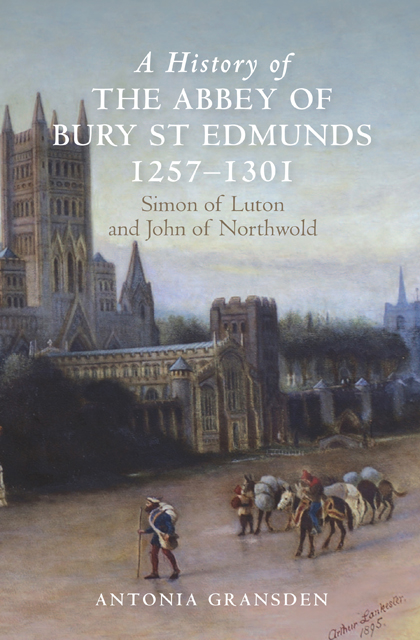Book contents
- Frontmatter
- Dedication
- Contents
- List of plates
- List of figures
- Preface
- Editorial note
- Dedication
- Acknowledgements
- Abbreviations
- Maps and plans (figures 1–11)
- Part I Introduction
- Part II Abbatial Governance
- Part III The Abbey’s Economy
- Part IV Religious Life and Reform
- Part V Intellectual and Cultural Life
- Appendix I The identity of the abbot’s justices, Henry of Guildford and Henry of Shenholt (in 1287)
- Appendix II The monks’ dietary regime: their food and drink
- Select List of the Registers and Customaries Cited
- Select List of Further Manuscripts Cited
- Select Bibliography
- Index
- Backmatter
3 - Repercussions on the Abbey of the Barons’ War
Published online by Cambridge University Press: 22 February 2023
- Frontmatter
- Dedication
- Contents
- List of plates
- List of figures
- Preface
- Editorial note
- Dedication
- Acknowledgements
- Abbreviations
- Maps and plans (figures 1–11)
- Part I Introduction
- Part II Abbatial Governance
- Part III The Abbey’s Economy
- Part IV Religious Life and Reform
- Part V Intellectual and Cultural Life
- Appendix I The identity of the abbot’s justices, Henry of Guildford and Henry of Shenholt (in 1287)
- Appendix II The monks’ dietary regime: their food and drink
- Select List of the Registers and Customaries Cited
- Select List of Further Manuscripts Cited
- Select Bibliography
- Index
- Backmatter
Summary
More serious than St Edmunds’ dispute with the Friars Minor and that with Richard, earl of Gloucester, were the repercussions of the Barons’ War on the abbey and the town. Before discussing the war’s impact in more detail something should be said about the monks’ general attitude to the barons and to the king. The Bury chronicler, John Taxster, gives a valuable and more or less contemporary account of events. His few hints which throw light on his attitude to politics suggest that he, like nearly all the other monastic chroniclers, favoured the baronial party: this was probably the general view of the rest of the convent. He is critical of the king and queen and emphasizes the king’s severity after the battle of Evesham. Taxster’s view of Henry is coloured by the xenophobia typical of England in this age. Commenting on Henry’s harsh treatment of the vanquished, he asserts that the king arbitrarily distributed their lands to aliens as well as to Englishmen, and he remarks that if the barons had not guarded the coasts in 1264 against the threatened invasion from France by Queen Eleanor’s forces, ‘England would have been conquered by foreigners’. Taxster, like many other chroniclers, regarded Simon de Montfort as a hero and even, because of the circumstances of his death, as a martyr. He goes so far as to state that ‘many people said’ that de Montfort’s corpse worked miracles. Nor was the posthumous cult of de Montfort unknown at St Edmunds. Maybe the monks’ views were influenced by the Friars Minor at Babwell, since the friars were the cult’s main proponents. Indicative of the monks’ attitude is a rare fragment of a motet in honour of de Montfort surviving from the abbey. It is in a hand of c. 1270, but it was soon discarded and used as a pastedown and flyleaf of a thirteenth-century copy of the Summa de vitiis of Guilelmus Peraldus. Henry’s restoration to power in 1266 and the strong measures taken to suppress de Montfort’s cult could explain the quick scrapping of the motet. Possibly it was at the same time that the notice of de Montfort’s corpse working miracles was erased from Taxster’s holograph copy of his chronicle.
- Type
- Chapter
- Information
- A History of the Abbey of Bury St Edmunds, 1257-1301Simon of Luton and John of Northwold, pp. 26 - 33Publisher: Boydell & BrewerPrint publication year: 2015



